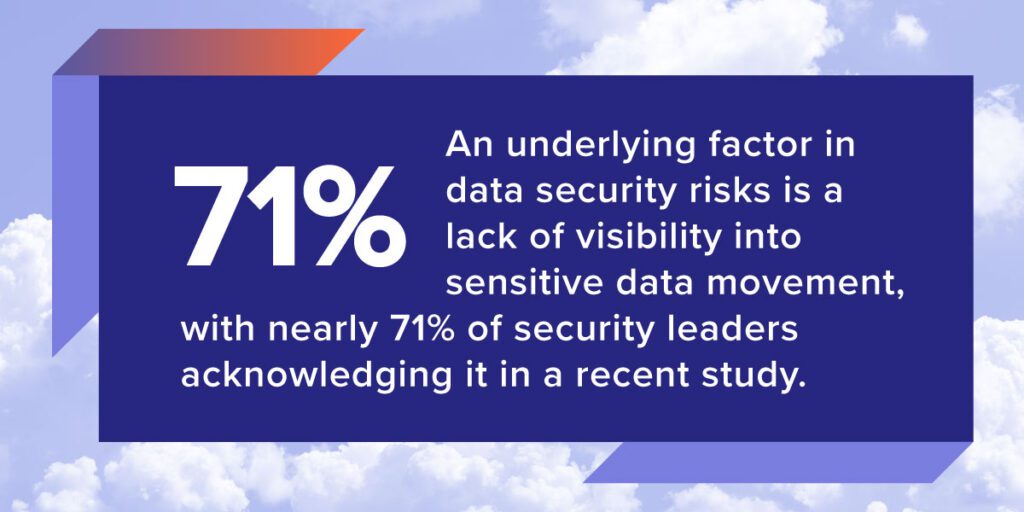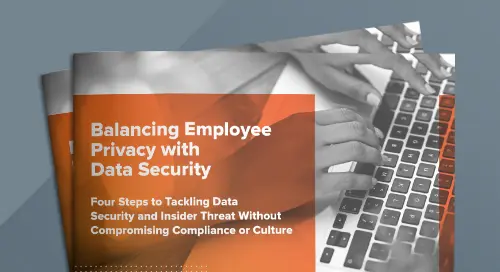What Is Data Security? Definition, Types & Risks

Data security leaders have their hands full. From securing remote and hybrid work environments to complying with changing privacy regulations to managing complex data exploits — there’s no shortage of security undertakings.
With these evolving circumstances, staying current on data security techniques and principles is essential.
In this guide, you’ll get a refresher on modern data security methods, emerging threats and best practices to combat them for your company.
Table of contents
What is data security?
Data security is the process of protecting an organization’s electronic information by mitigating the risks of unauthorized access, theft (especially of intellectual property or IP), corruption and deletion. These hazards can arise from insider threats like negligent employees, non-secure cloud app behavior and hackers.
An underlying factor in data security risks is a lack of visibility into sensitive data movement, with nearly 71% of security leaders acknowledging it in a recent study.

To help increase visibility into risky data behaviors, companies can implement a security framework of policies, processes and technology that rely on proactive employee training.
Without this framework, your company can face consequences from several angles.
Why is data security important?
There are three significant reasons why it’s vital to safeguard your company, employee and customer data:
1. Comply with legal obligations
Your company likely abides by various data privacy and security regulations that can incur steep fines for incompliant businesses.
A few examples of these rules include the European Union’s General Data Protection Regulation (GDPR), the United States’ Health Insurance Portability and Accountability Act (HIPAA) and Sarbanes–Oxley Act (SOX), California’s Consumer Privacy Act (CCPA) and the PCI SS Council’s Payment Card Industry Data Security Standard (PCI DSS).
With many laws and standards to follow, it’s important for security leaders to work closely with governance, risk, and compliance (GRC) teams to avoid incompliance and potential reputational and financial damage.
2. Prevent reputational risk
Customers are becoming more conscious of how companies and partners use their data. Consumer-facing companies can experience a 5–9% decline in reputational intangible capital following a significant data breach.
While companies outside this scenario may not sustain the same degree of reputation damage, it’s important to keep it in mind as data breaches continue to happen more frequently.
3. Avoid financial losses
Data breaches or corruption can lead to financial costs like lawsuits, mass refunds and even ransom. In 2022, the global average cost per data breach amounted to 4.35 million U.S. dollars.
While insurance can mitigate some of these financial risks, it’s rarely sufficient to compensate entirely for these wide-ranging expenses. Insurance also doesn’t account for customer churn or reputational damage, which can have a lasting impact on your business’s bottom line.
Data security vs data privacy
Data security and privacy are complementary processes in a broader data protection practice.
Where data security is an approach for protecting all of an organization’s data from risks, data privacy focuses more on handling personal data in compliance with laws, regulations and best practices.
With these two concepts in mind, ensuring your data security practice doesn’t hinder employee productivity or sacrifice data privacy is critical. The right tools, strategy and communication can help protect your business and stakeholder data while empowering and trusting your employees to work more constructively.
See how to achieve employee privacy and robust data security by downloading The Guide to Balancing Employee Privacy With Data Security.
Best practices for ensuring data security
Data security techniques can vary based on your organization’s unique use cases, but some standard best practices exist.
While some cyber security solution providers may advocate for data backup as a critical security measure, this strategy can incur high costs when storing large amounts of data.
Instead, here are five robust data security best practices you can deploy:
1. Ensure physical security of servers and devices
Whether your company stores data on-premises or in the cloud, you should check that your organization or cloud provider secures facilities against intruders, fire damage and changing climate conditions.
If storing data on-premises, your team can analyze a physical device’s security throughout its lifecycle. For example, when disposing of a server, it’s essential to delete data from the device before discarding it. Or, if someone damages or destroys a machine, take appropriate security measures to guarantee it doesn’t get into the wrong hands.
2. Implement access management and controls
Identity and access management (IAM) processes define who can interact with software or data systems so that only people with proper permissions can view or edit data assets. A single sign-on (SSO) system is an excellent example of IAM technology, as it enables your security team to set user permissions across platforms in your organization.
To streamline this practice, you might define access controls by roles or groups of people. For example, IT administrators or executives may have access to a wide range of data. In contrast, contractors or external vendors likely have a much narrower scope. This framework simplifies the administration process and minimizes the chance of accidentally granting too much access to a new user.
3. Stay updated on application security and patching
Due to unpatched vulnerabilities, misconfigurations and user errors, security susceptibilities constantly arise in software applications and operating systems. Encryption protocols governing how a company stores and transmits data can also expose an organization to harm since they change frequently.
To avoid these precarious situations, security administrators and software developers must regularly patch and upgrade their company’s software to verify they’re not running any compromised code. Regular audits of all software libraries an organization uses can also help minimize the chance of your team missing an employee using an old software package.
4. Educate employees proactively on data security
Without proactive, strategic security training, employees can unknowingly expose your company to risks — like connecting to an unsecured network or downloading unapproved applications.
Instead of an extended video module plan that people potentially write off as a yearly “checklist item,” offer your employees a beneficial interactive program that helps them recognize their risky data behavior.
For example, if an employee tries to send patented information to an unapproved shared drive, have security software that flags the behavior, alerts your security team and helps contain the damage by automatically sending the employee a brief reminder on approved sharing.
Lastly, encourage your security team to be open and collaborative during employee training. You want employees to reach out about concerns before damage happens.
5. Monitor all data and its movement on network and endpoints
With most companies embracing hybrid and remote work, data is increasingly moving to edge devices like laptops and phones — presenting new security vulnerabilities.
In particular, companies can no longer rely on strict on-premise firewalls as the primary way to contain data flow and prevent the risk of data exfiltration.
To combat this hazard, some security teams flag specific data movements as risky or only monitor certain important data. But even with the most complex policies and tools in place, data still slips through the cracks. It’s more effective to treat all data as potential IP and monitor file movements to untrusted locations.
Looking for a solution that monitors all data movement? Discover Code42’s Incydr and how it gives you the visibility, context and control needed to stop data leaks before damage occurs.
Types of data security
With these best practices in mind, there are several types of data security methods you can use, often in combination:
Encryption
Encryption is the process of converting data into an illegible code called ciphertext that someone can’t convert back to the original data format without access to a private mathematical key. This type of security allows companies to store data securely on hardware and transmit it between online devices without someone intercepting and accessing the actual data.
For example, if an employee sends emails while on a public WiFi network in a café or airport, encryption prevents hackers from intercepting their communications and stealing company information.
Data masking
Data masking is a form of encryption that modifies sensitive information like PII so that an employee can use the data without unauthorized parties accessing it. This method often involves obscuring and replacing specific letters or numbers.
Software developers and QA analysts use this technique frequently to test code against production data. While the data structure remains the same in these tests, the masking process ensures companies don’t expose sensitive information like names or emails.
Data erasure
Data erasure is the process of overwriting and deleting data so that no one can access it.
Unlike access control systems, data erasure is a permanent and irreversible process that deletes the data for all users regardless of their access level.
Data erasure is the strictest form of data protection, and security teams should only use it for data that the company no longer needs and won’t need in the future.
Deleting data reduces a company’s overall risk profile, as security teams have fewer data assets to maintain and monitor. Some organizations set redaction periods where a business’s security systems automatically delete data over a certain age.
Data resiliency
Data resiliency is the ability of a system to maintain access to data assets in the face of disruptions like corruption or hardware failure. For example, if a server fails, a resilient system will have processes to restore access to the data stored on the failed machine.
Most significant risks to data security
The data security landscape continues to evolve as work migrates to the cloud and remote access models. These changing conditions have created some significant risks to data security:
Insider threats
An insider threat is a cyber security risk introduced by an individual with permitted access to a company’s systems and data. They can arise from anyone using an organization’s network or applications, such as employees, partners, vendors, interns, suppliers or contractors.
For example, when an employee puts in their two weeks and prepares to move on to a new opportunity, it’s not uncommon for them — maliciously or not — to take company data with them. They might send files to their personal email account or use a thumb drive.
There are many real-life examples of insider threats wreaking havoc on organizations, so it’s crucial to have processes and technology that can detect and prevent risky data movements before it’s too late.
Non-secure cloud app behavior
While cloud technology and tools have enabled new ways of working, they’ve also intensified the scale and impact of data exfiltration.
Some of the most common non-secure cloud app behaviors include:
- Using untrusted personal devices to log into corporate cloud apps
- Making private cloud links publicly available
- Downloading corporate data via cloud app to a home device
- Using unsanctioned clouds (usually personal clouds) to share data with 3rd parties and colleagues
Whenever an employee or authorized user performs one of these actions, they compromise cloud security and put your company data at risk.
Hackers
Hackers are constantly creating new approaches to extract, steal and exploit data from organizations. Ransomware and phishing are two common attacks.
These threats are particularly challenging to ward off as they typically use psychological tricks to get information from careless or untrained employees.
Data security solutions
To combat these risks, you can use a variety of data security technologies and strategies:
- Identity Access Management (IAM): This solution facilitates managing electronic identities, often through single sign-on (SSO) or multifactor authentication.
- Security Education and Awareness (SEA): Employees are your first line of defense against data security risks. Using tools and strategies that help you teach them security best practices can help limit exposure.
- Zero Trust: Zero trust architecture is a security model that requires all users to complete continuous authentication when accessing internal applications, data and servers.
- Data Loss Prevention (DLP): DLP solutions detect potential data leaks and exfiltration. They require extensive data classification, and if a company doesn’t classify a particular data set, it goes unmonitored by a DLP.
- Insider Risk Management (IRM): IRM solutions are a risk-based approach to data security. Unlike conventional DLP methods, IRM solutions monitor all data movement, not just data a company has already labeled. They automatically prioritize high-risk data exfiltration and help security teams respond promptly to incidents without impeding employee productivity.
Awareness of all the possible mechanisms for securing your data can help you evaluate what solution or combination would work best for your organization.
Keep your data secure no matter what lies ahead
Data security is vital for businesses to protect remote and hybrid work environments, comply with evolving privacy regulations and mitigate risk. However, accomplishing these goals requires monitoring all data without hindering employee collaboration and productivity.
An Insider Risk Management solution like Code42’s Incydr can help you do this while meeting the complex requirements of a rapidly changing workforce.
Find out why Insider Risk Management is the fastest-growing category in data protection and security when you download Gartner’s IRM Market Guide.
More Resources
The post What Is Data Security? Definition, Types & Risks appeared first on Code42.
*** This is a Security Bloggers Network syndicated blog from Code42 authored by Code42. Read the original post at: https://www.code42.com/blog/what-is-data-security/








